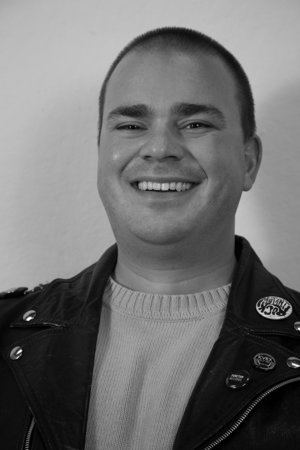
Interview with Joshua Gamma
Transceiver Radio: Broadcast Series from Oct 1 2020-Dec 10 2020
Interviewed by Iona Nave Griesmann
Joshua Gamma’s practice lives at the crossroads of art, design, music, history, and activism, pulling from his nomadic upbringing as the son of a U.S. Coast Guardsman (growing up primarily in Louisiana and Texas); his experiences as a community radio DJ; the singer in the Austin, Texas, punk band The Mole People; a member of various art and activist collectives; and as a veteran of the U.S. war in Afghanistan. Gamma received a BFA in Design and a BA in Studio Art from The University of Texas at Austin in 2009, and an MFA in Curatorial Practice from Maryland Institute College of Art (MICA) in 2019. As well as being the Emerging Curator in Residence at VisArts in Rockville, MD, he is the Design Director at Current Movements; a D.C.-based nonprofit connecting activists, organizations, and movements around the world using film, art, and technology; and am currently designing a series of artist archive books with Minerva Projects out of Pine Plains, NY.
What is the theme/thesis of your upcoming show at VisArts? What were your main inspirations in bringing the artists in the show together?
As you know it got postponed, so the exhibition will not be until December 2021. I’ve been thinking a lot about it, but I also feel like the universe could be completely different by the time that show is realized. The overall theme is the enmeshment of Christianity and offshoot cults in the fabric of the United States, especially in the south, and looking at how everything in the U.S. is connected to that, whether we are talking about politics or pop culture.
There’s a rebelliousness about American Christianity specifically that’s very anti-authoritarian, but it can also be cultish and very authoritarian. There’s also a lot of amazing things I associate with American culture that have spun out of Christianity, like Christian utopian socialist communes that have influenced progressive movements; enslaved folks using the book of Exodus as a roadmap to freedom; gospel music becoming rhythm and blues and soul, then rock and roll; and of course the theological underpinnings of Dr. Martin Luther King, Jr.’s work in the civil rights movement. So, there are many beautiful things tied to that history, but there are also a lot of dark, twisted things like the KKK, white churches supporting slavery, segregation and white supremacy.
I’m working with a lot of artists where that’s part of their work, like S.M Prescott who is also a part of the Transceiver Radio project. They wrote a liturgy that we will broadcast over radio, and it will probably end up being part of an installation next year. They also make prayer banners that come from the southern charismatic tradition, but specifically are looking at it through a Queer lens, celebrating Queer sexuality. Another artist I’m working with, Rodrigo Carazas Portal, looks at Elvis Presley as a symbol. He’s from Peru so he’s looking at it more from the outside. He’s looking at Elvis almost as a religious icon, like Jesus, where you can take Elvis, put him in any culture and people will have an opinion about him. Elvis becomes this impetus to talk about religion, race, and capitalism. He’s the tragic hero who falls from grace. Elvis is also involved in a lot of conspiracy theories about aliens—which Rodrigo will be talking about on a conspiracy theory radio show.
One of the things that drove me to the concept of the show initially, is that I’m a huge rock n roll fan. I also grew up mostly in the south and in the church, so seeing that connection between charismatic preachers shaking, speaking in tongues, and what became rock n roll or punk rock has been super fascinating to me.
View Transceiver Radio Programming Schedule
Instagram: @TransceiverRadio
Do you have any favorite punk or rock and roll bands you like to draw inspiration from?
One of the things I did for years was play in punk bands. Thinking about that connection to charismatic Christianity was a big influence on me, like James Brown, Iggy Pop, David Bowie, Elvis Presley and these frontmen who almost become spiritual leaders, their role being to get the crowd involved, and to whip up the emotion. That’s something I pulled into a lot of my performances when I was in a band.
Also people like Miles Davis and George Clinton where they become figureheads; in a way they are curators. If you look at Miles Davis’s bands, you can tell he goes, “I like this guy, I like that guy… we’re putting them together because they’re going to be an interesting combo.” Especially in the 70’s, sometimes Miles is not even in the song until twelve minutes in, because he’s laying back letting other people do cool things.
Would you like to talk more about the purpose of the Transceiver Radio broadcasts? By inviting guests who combine art and activism, how do you inspire your listeners towards a desire for change?
This project is pulling from the tradition of community radio as a public platform that anyone can get involved in. I’m also drawing a distinction between a community radio station and a public radio station like NPR—because they are usually connected to the government and they’re a little more professionalized. Typically DJ’s at NPR have been in the business for a long time, while in a lot of community radio stations it’s completely volunteer. Anyone can do it if they pay their dues, sweep up the station or whatever they’re tasked to do for the first six months. I think there’s something beautiful in that co-op-like institution—the goal is communication. I’m also a student of the history of community radio. I think community radio is a place where art and activism come together a lot.
I know especially with Trump getting elected, a lot of artists, myself included, were put in this place of “what do I do? What is my responsibility in this situation?”
There’s a long history of social practice in visual art, but it sometimes falls short because it’s still so much in its art head. Like—and I’m not referencing anyone in particular here—some German artist will go to a lower income neighborhood in Chicago, be there for three weeks, and that’s it. It doesn’t have the deep accountability that movement organizers strive for. So I think something that is really important is showing artists that there are people on the ground already doing the work, tied into grassroots organizations. As an artist you can join these movements; you need to be accountable to them. I think there’s a powerful potential for artists to really get plugged in, and for movements and activists to realize how powerful art, design, and music are for amplifying their message, communicating in ways that might not be so traditional, or so straightforward.
How did you come across/create Current Movements? Can you share more about how you use the platform to connect activists and organizers using film, art and technology?
To be clear, I did not create Current Movements. Current Movements is an organization that has existed in Washington D.C. for maybe three or four years. The woman who formed Current Movements is Katie Petitt. She was really involved with Black Lives Matter, and she organized at Standing Rock.
A good friend of mine Joseph Orzal has an art platform in D.C. (now Baltimore) called Nomü Nomü, and he was in the same Curatorial Practice grad program I was in at MICA. My graduate thesis show was Transceiver Radio, and his was a show called Hedonist Buddhist, which was all about gentrification. He grew up in D.C. so he’s experienced the gentrification there firsthand. One of the things he was doing for programming was bringing in local activists.
There was a lot of overlap politically and conceptually between my project and his—he was working with Go-Go musicians talking about how music could be used for activism—so we were collaborating with each other when we could. Katie, I believe was leading some Black Lives Matter meetings at his gallery, which was the annex of the Washington Project for the Arts, and I met her through that. Initially we started collaborating because she needed design work.
Me, Katie, and Joseph Orzal from Nomü Nomü also worked on a project called The People’s Platform Poster Project, where Joe reached out to a poster company in Peru involved with Chicha music. Joe noticed parallels between Chicha culture in Peru and Go-Go culture in D.C. Both are underground music movements associated with marginalized people. They both have a vibrant rainbow aesthetic in their handmade posters. In D.C. with Go-Go, it’s Globe Poster with heavy wood type and explosions of bright colors. In Peru, the Chicha posters have beautiful handmade lettering. I think he saw that somewhere and said “this is amazing, we should reach out to these people.” I had a Chicha music show on Transceiver Radio hosted by a D.C. DJ group called León City Sounds, so maybe that’s how I got involved? Katie wrote all the political phrases that became the posters. It was this really interesting thing where music, activism, and art were all coming together.
I also ended up doing the design work for the Current Movements Film Festival last fall, which was amazing, having great panel discussions with filmmakers, artists, and activists. But as COVID hit, it became clear that she was probably not going to do another film festival this year. So the conversation started to revolve around what we were going to do, and how the organization would exist in COVID.
She knew my background with radio so we decided to create a podcast, and that was the first broadcast for the Transceiver Radio broadcasts for VisArts this fall. It’s mostly her and another film maker Mayuran Tiruchelvam, a film professor who has Sri Lankan roots. They write it together and my role is more of a producer, hooking them up with VisArts to do their first event. Current Movements is also working on something called Feed the Reel, which is going to be an online community for people interested in getting involved with filmmaking. It’s on a platform called Mighty Networks, which kind of operates like Facebook or Reddit but it’s completely self contained, so you can filter out trolls, you don’t have any ads. It’s just conversations.
Learn more about Current Movements
Your work is often collaborative, whether it comes to curating or radio broadcasts. Have you always been a collaborative person?
Yes and no. The early form of my art practice was really solitary. I drew in my bedroom and painted, I used to make cassette tapes that were collages of things I found off the radio, and would make album art. But it wasn’t until college that I started to view my work as collaborative.
But growing up I was always involved in collaborative things. I was in boy scouts, in church youth groups, right out of high school I was in the military, and all these things that are about people coming together and making things happen. At some point I started taking some of the tools I learned in these organizations to do more interesting things, while using art as a broad umbrella. My design background is a big part of it too. In design you have the client-designer relationship, and design studios also often have a collaborative atmosphere. I feel like I really thrive in these situations where I’m one voice in a group, where we can all come feed off each other and build something greater than the sum of our parts. There’s something really magical when you’ve got a lot of different voices in solidarity.
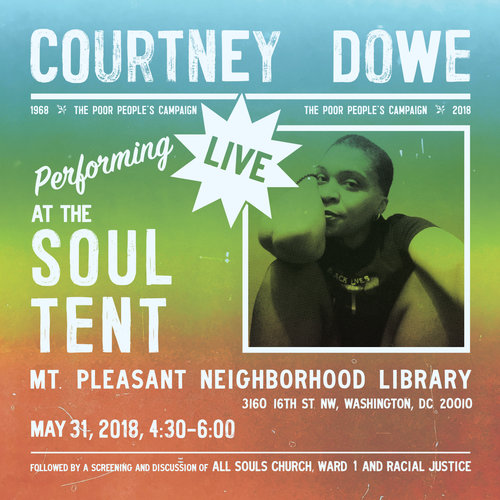
Flier for Courtney Dowe performance, 2018 (design by Joshua Gamma)

Is there any advice you would like to give to other emerging artists and curators about being a good collaborator?
I think this goes back to some of the stuff I was saying earlier about social practice. I think part of why I lean more into calling myself a designer versus an artist is because I’m in these collaborative situations. Sometimes I want to take a little bit of the authorship away from myself, and say that this is really a project coming out of this moment with these people.
Listening is super important, and don’t let your ego get in the way, especially if your goal is to amplify or uplift marginalized people, especially if you’re white. Your job is not to be like, “I’m the genius artist and I came in and did this thing that saved the day,” your job is to be an amplifier, and you need to take your cues from the people who are the most marginalized. And if you are going to do something where conflict is the goal, always ‘punch up.’
And be flexible! That’s another huge thing for me. I’m a fan of John Cage, and the idea of randomness is super important. I think something a curator, artist, or designer can do is create a structure that has lots of gaps for randomness. That’s how I look at exhibitions or radio programming. “These are our constraints, this is our time and our schedule, but from this hour to this hour do whatever you want, have fun!” That’s a huge one too. If you’re not having fun, what’s the point? Why be an artist if you’re not going to have fun?
Your projects often have a goal of uplifting the voices of others to organize and find community. How did you learn to use design in this manner, especially considering the educational aspects of design where the focus is almost exclusively corporate?
I feel like I’m really lucky. I did the Design program at the University of Texas in Austin, which from all reports that I’ve gotten from people, isn’t really a thing anymore in the way that it was when I was there. I think from the late ’90s up until a few years ago, it was a pretty avant garde program; it looked at design more as kind of a lense to view the world, versus “I’m going to make this corporate logo and letterhead.” That was never even anything that we were taught. Even learning Photoshop and Illustrator were kind of secondary. The main thing we talked about was the history of design, different theories around design and design thinking. It was always framed in this way of how the way you approach anything could be a design project. Depending on what the problem was, you could design a chair, a typeface, or an event.
I also studied art and design simultaneously, so I think part of my work has always been how I put these divergent practices into a design framework and look at it through a design lens. So, I feel really lucky that I’ve never felt super tied into a corporate way of thinking about design.
Did you ever feel any pressure to follow a certain path at any point in your career?
Yes. I graduated from undergrad in 2009 right at the height of the Great Recession, and that was very difficult. In some ways I look back at it as a blessing, because it forced me to do a bunch of weird crap that I wouldn’t have done otherwise. But friends who graduated a couple years before and a couple years after me got corporate design jobs. That wasn’t even an option in 2009, especially with a portfolio like mine that was super weird. So yeah, I definitely felt pressure to learn how to code and hone my corporate logo skills.
I can do that kind of work if I want to, and have done plenty of that kind of work because you gotta make a living. But over the years of doing a lot of freelance work and a lot of strange projects, I’ve built up enough of a portfolio that I’m now at a point where people know that I do interesting projects, and will hire me because of my uniqueness. But it takes a long time, and it takes getting to a point where you are comfortable asking for what you are worth.
In your opinion, what sets the design and art world apart, or what makes them alike? Do you consider design/curating to be a form of art in itself?
This is an interesting question for me, because I’ve always been an insider/outsider—in both worlds. Going back to when I was in college, I remember all my design friends were like, “ you’re super weird and you have all these crazy ideas!”, and then all my friends in my studio art classes were like, “you’re really organized and focused, everything’s very tight and written out.”
So it just depends on your context. In the conversation we just had about money, I feel like traditionally, or at least over the course of my work, that’s been more of an okay thing to talk about in design. I feel like in the art world, sometimes that can be a little taboo. I think that’s changing, but there’s a little bit of an attitude in the art world of, “why are we talking about money? Don’t worry about the money,” or artists being afraid to ask for what they’re worth. That’s definitely something I try to bring into my curatorial practice, if you’re doing something you’re getting paid.
I think just a little bit more focus on practicality in the design world is the main thing that I’ve noticed… and a temptation to be corporate. I will say that you can bring the worlds together, and they overlap a lot.
Your work frequently tackles a variety of socio-political issues, many of which have received more attention 2020. Have you found your practice shifting at all this year?
My first instinct is that my focus hasn’t changed all that much, because I have been thinking a lot about issues like racism, poverty, and gentrification over the last few years. But in other ways, a huge part of my practice was social gatherings, and those can’t happen now. The original iteration of the Transceiver Radio project was super social. It was radio programming that was being broadcasted, but it was also a radio station where we had parties. People were in the space all the time, we had couches, we had happy hours where there were free drinks, so it’s a bummer how that’s not happening now. When I was talking about the institution of community radio stations, the community aspect of it is very important, and those things are put on pause.
As far as some of the topics, the only thing I feel that has changed, is typically when I’ve done radio shows that are more music oriented in the past, they’ve been more joyful and celebratory. Like I mentioned before at Transceiver Radio version 1.0 we had DJs who were playing Chicha from Peru, and in my own personal radio show that I did for a long time, I played mostly psychedelic rock, garage rock, and old school rhythm and blues. It always had a good-time vibe. I can’t make myself do a show like that right now, it doesn’t feel right for me personally. So the one music show we are doing for Transceiver Radio right now is very solemn. I’ve been thinking about it in terms of collective mourning. That is not something I think I would’ve done six months, or a year ago.
I have been thinking a lot, and have thought a lot over the years about how crucial the African American experience is to everything in American music. That’s not a new thing to be thinking about, but before I thought about it more in terms of rhythm and blues, soul and how they influence rock n’ roll and dance music, but now I’ve been thinking about it more in terms of the cathartic, spiritual aspects of jazz, blues, and gospel. A lot of it is very mournful, and I think something we are not really doing right now is letting ourselves grieve. The title I’ve given the show is Night Music, which is a nod to a jazz-centric TV show from the 80’s. Lorne Michaels from Saturday Night Live produced it, and it was a really strange juxtaposition of jazz musicians, punk bands, and pop musicians. So it’s a nod to that, but it’s also thinking about ‘night’ as being a time of solitude and darkness, a time to reflect. That vibe is not something I would have done otherwise.
As far as doing the more somber things, I’ve been kind of enjoying it, and I think that it’s because it’s something I need, and I think it’s something the world needs. Even in the way that I’ve structured Transceiver Radio, last time it was a month long, and we had programming constantly. I basically lived at Transformer in D.C. When I was there every day, it was super fun and it was beautiful, but it was also very stressful. Now we are doing a program, most of the time it’s every couple weeks. And when I play music it’s very relaxing, often somber. But I think it’s just allowing for that quiet that I think we all need. We all need media that is slower.
That’s all the questions for today! Thank you for taking the time to talk about your work.
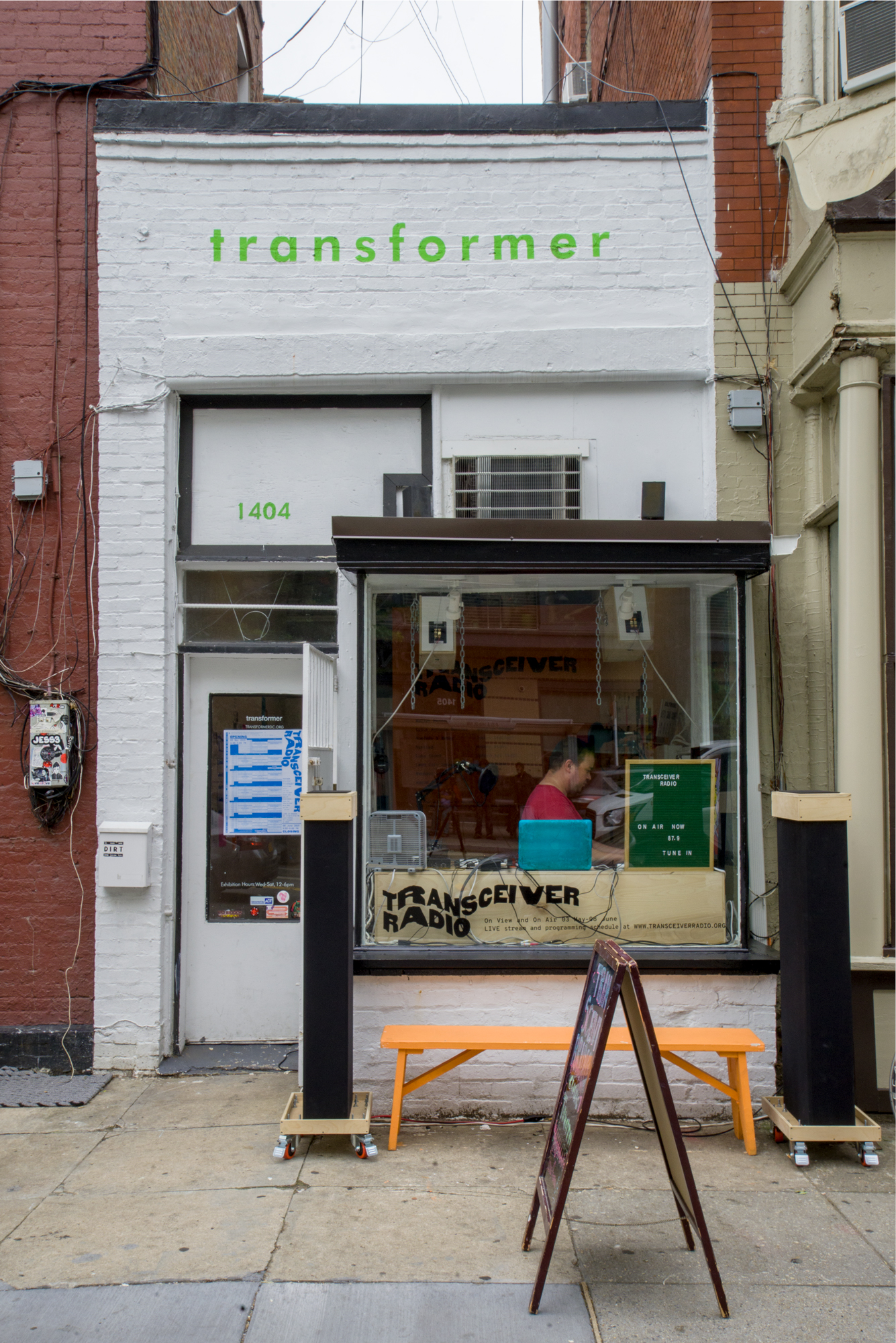
Transceiver Radio Studio space exterior
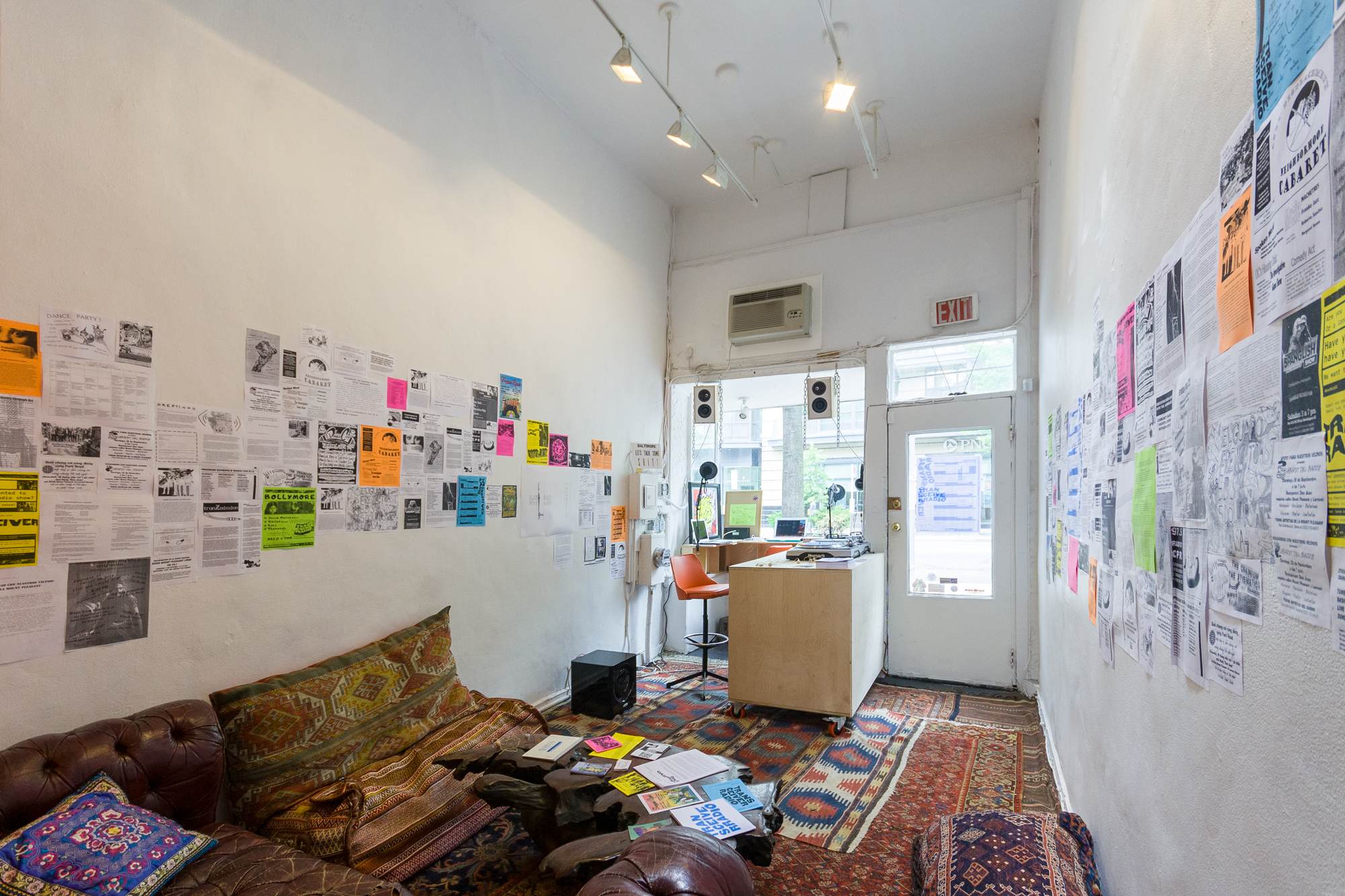
Transceiver Radio Studio space interior
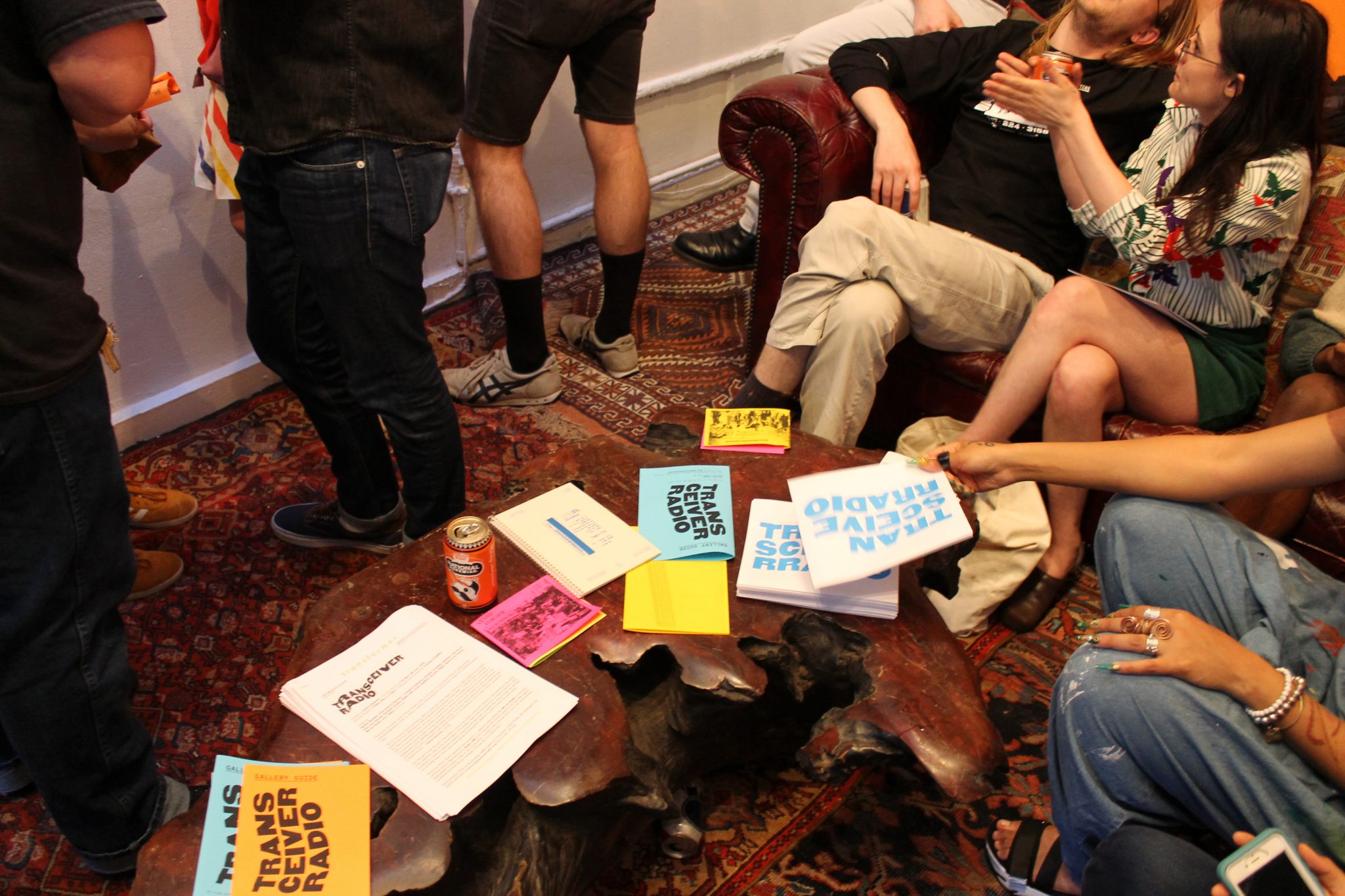
Learn more about past projects done by Transciever Radio at Transformer D.C.
To see more of Joshua’s Work, Visit: http://www.joshuagamma.com
This interview was conducted by Iona Nave Griesmann, an Intern at VisArts and current Illustration/Graphic Design student at Montgomery College. Their work can be found at @Iona_Nave on Instagram.
